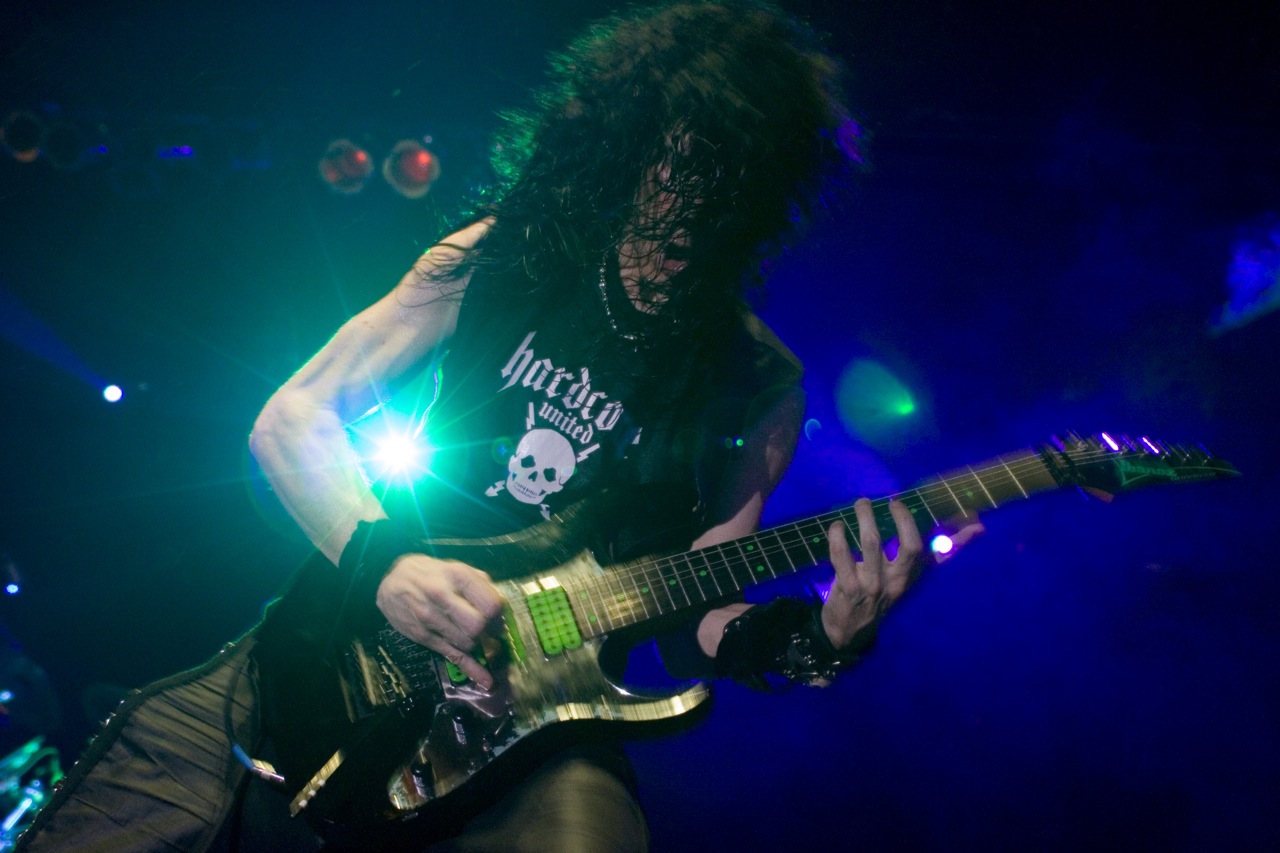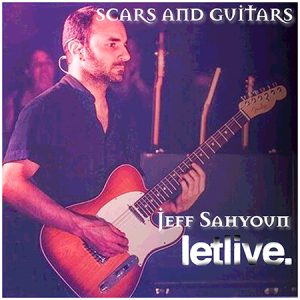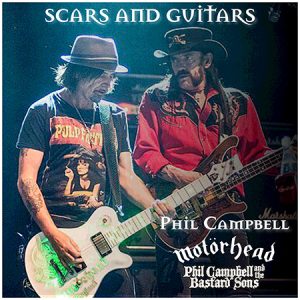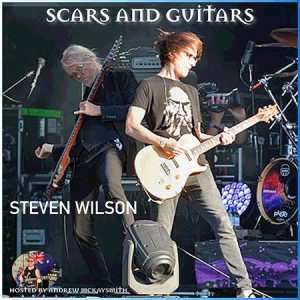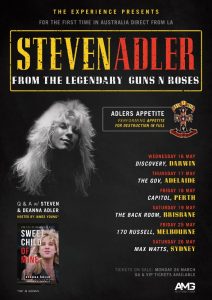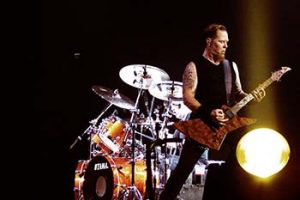Introduction.
George Emmanuel III is better known as the brilliant death metal guitar virtuoso, composer and producer for Morbid Angel, Trey Azagthoth. He is a man who is shrouded in mystery. There are only a few interviews with Azagthoth online, and many of those predate 2003, the year the Morbid Angel album Heretic was released, so it’s fair to say that gaining an insight into the man presents a challenge.
I spoke to longtime bassist and frontman for Morbid Angel David Vincent for an episode of the Scars and Guitars podcast series in May 2017 (listen here). David was a gentleman who humoured my many questions about former bandmates and musicians he has worked with. When I asked him for his views on Azagthoth, this is his response:
“Trey is a very creative guitar player; there’s no doubt about that. And I will always respect that.”
I couldn’t blame Vincent for offering a short response to my query, given he parted ways with Azagthoth under what we can assume were fractious circumstances. If nothing else, it was interesting to hear that Vincent even mentioned Azagthoth’s stellar guitar playing when asked for a quote.
As Vincent alluded to in his comment, what we as an audience do know about Azagthoth we know by and large through the man’s outstanding guitar performance on Morbid Angel records. Not necessarily such a bad thing when so many artists are quoted and used by various web-based publications to attract hits or clicks, raising a revenue profile through increased advertising that traffic following a controversial statement can bring. There is an absence of interviews with Azagthoth, which forces us to focus on the music he creates.
Why is Trey so unique?
Death metal is the universally acknowledged genre associated with Morbid Angel. As a sub-genre of heavy metal, featuring down-tuned guitars, double kick, blast beat drumming and percussion, gruff or hoarse vocals and an image typically associated with death, destruction, anti-religious themes and the darker aspects of life.
Morbid Angel’s take on death metal includes lyrics and song titles steeped in the imagination of HP Lovecraft and almost constant double-kick drumming by one of the best percussionists in the biz, the El Salvadorian-born marvel Peter Sandoval.
Vincent’s bass lines, by and large, follow the root note of the melody the guitar is playing with an occasional burst or fretted trill for a sonic surprise. Vincent offers a gruff vocal that occasionally incorporates a deep bass and clean singing style, and then there is Azagthoth’s Van Halen meets Jimi Hendrix guitar solos and riffage.
I just mentioned what makes Azagthoth’s guitar playing so unique. Very few guitarists in death metal, indeed only a few from the same era that spawned Morbid Angel, could be considered multi-dimensional.
Rapid sweeps of the fretboard are built into Van Halen-esque guitar solos, clearly definable riffs that are both memorable and brutal- indeed, many of Morbid Angel’s best riffs can be neatly transposed to an acoustic guitar. Correct technique of the fretting hand featuring numerous slides and vibrato evoking feeling and rich emotion, which is the essence of Azagthoth’s brilliance. He holds the guitar higher than many of his contemporaries, so the picking hand is above the waist, often at stomach level, similar to a fingerstyle bass player. The picking hand is responsible for ferocity through impeccably crisp and even alternate picking strokes.
Azagthoth’s style is near impossible to mimic. Bill Hudson, Ira Black, and now Kelly McLauchlin are doing a tremendous job in the David Vincent vehicle I Am Morbid. The premise of I Am Morbid is to play classic album cuts taken from Morbid Angel’s first four albums. Check out the videos of the band’s performance posted to YouTube.
Azagthoth is essential not just to death metal and heavy metal but to guitar playing. The foundation of his legacy is through Morbid Angel’s first three albums: Altars of Madness (’89), Blessed Are the Sick (’91) and the commercially successful Covenant (’93). Covenant is an album many fans of traditional radio rock accepted as the first and perhaps only foray into the world of extreme metal. I will dedicate part of the blog to discussing the brilliance of Covenant. The final cut on the album is called “God of Emptiness” it’s a towering example of Azagthoth’s brilliance.
The Early Years and the demo album.
Morbid Angel was formed in 1984 in Tampa, Florida, by Azagthoth alongside drummer Mike Browning. Browning left Morbid Angel before the album’s recording that is universally understood to be the band’s debut for Combat Records/ Earache Records, the seminal Altars of Madness. Browning is still active through his project Nocturnus AD, which released the brilliant Paradox in 2019, a legacy of the prog-death metal band Nocturnus. Nocturnus achieved cult status among metal fans due to their 1990 release, The Key, which features cosmically laced sci-fi themes overlaid with an occult narrative.
Browning recorded vocals and drums for what was intended to be Morbid Angel’s debut album. Recorded in May 1986, it was a recording that would eventually see the light of day as Abominations of Desolation in 1991. The band call it a ‘demo album.’ It’s a harsh listen, devoid of Vincent’s vocals and bass playing, not to mention the drumming of longtime Morbid Angel percussionist Peter Sandoval, the sound of the recording leaves a lot to be desired. I can understand why Azagthoth regrouped. It’s the sound of an artist getting used to the studio.
Many of the tracks on Abominations of Desolation have been re-recorded and released elsewhere. All except for one, “Demon Seed.”
In 1987, the Chuck Schuldiner project, aptly titled Death, released Scream Bloody Gore, an album considered by many to be the first example of death metal put to a widely available recording. It remains to be confirmed. However, I wonder if the decision to regroup and reform Morbid Angel after the recording of Abominations of Desolation was due to Azagthoth hearing the ferocious album from Schuldiner and thinking ‘game on’!
There is a widely circulated quote from Azagthoth about the band’s nascent debut. He is reported to have said:
“Back then, I wanted to destroy everybody. I wanted people to work much harder after the fans witnessed what we had going on. I wanted to smoke people. I believed that bands were challenging each other, trying to outdo each other and make each other quit – almost like the rivalries between East Coast and West Coast rappers. I thought people wanted to write parts that would engulf the whole world. I wanted to get on stage and have people go, ‘Holy shit – what the fuck is going on?’ I wanted to write stuff that would make other bands run and hide. It’s not very nice, but that’s what drove me.”
Where it all truly begins: Altars of Madness.
On May 12, 1989, Morbid Angel would release Altars of Madness and the blueprint for death metal as we still know it today was issued.
Featuring the classic lineup of Vincent on bass and vocals and Sandoval on drums and percussion, Azagthoth was joined on guitar by Richard Brunelle.
The album’s strength is that it’s one of the most continuously referenced death metal albums ever recorded. Azagthoth and Brunelle’s performance is the fastest, most brutal, yet still legible guitar recording to that date. I can only imagine what a first-time listener would have thought back in 1989, given the current musical landscape dominated by Madonna, Bobby Brown, and Paula Abdul.
Altars of Madness were recorded at Morrisound recording facility in December 1988. The band produced it alongside Digby Pearson, the founder of UK-based Earache Records.
The album sleeve features classic artwork designed by Dan Seagrave. According to Seagrave, the image is “more like a flat disk made of a fossil material, that has captured souls.”
The remarkable sophomore album: Blessed are The Sick
Azagthoth returned to Morrisound Recording studio in 1991 with the same Morbid Angel lineup that recorded Altars of Madness. Released in May of the same year, Blessed are the Sick is revolutionary due to adding a denser and brooding song-writing narrative.
Some fans were a bother due to the perception that Azagthoth had produced more manageable riffs to the aural senses. Repeated listens uncovered a complicated morass of riffs that were as brutal and intense as the debut. If anything, the addition of slower times signatures added a sense of menace only hinted at on Altars of Madness.
The album artwork is a Jean Delville creation; it’s an adaptation of the artist’s painting titled ‘Les Trésors de Satan’, which translates as ‘The Treasures of Satan.’
The tour to support Blessed are the Sick would eventually arrive on Australian shores. I was in a band with a drummer who met Richard Brunelle. My then-bandmate commented that Brunelle was down to earth and willing to chat with the fans.
Covenant: A masterpiece in death metal performance.
Sometime between touring commitments for Blessed are the Sick concluding and studio commitments for Morbid Angel’s third album, Covenant, commencing; Brunelle left the band. He was not replaced, not immediately anyway.
With so many accolades and praise afforded to Azagthoth’s work across Morbid Angel’s first two albums, one would think that a release to rival, let alone best, those albums would be beyond the reach of the musician.
Released in June 1993, many critics have long since hailed Covenant as the most exceptional death metal recording. Distributed on the major label Warner Brothers through their Giant imprint, Covenant had significant resources available for promotion. Tony Kunewalder directed videos for the album cut’s “Rapture” and “God of Emptiness,” David Vincent participated in interview specials on MTV, and the band made an appearance in the zeitgeist of 1993; a feature on the Mike Judge show Beavis and Butthead.
My recollections of the video for “God of Emptiness” are of a winged demon summoned by believers; Azagthoth wields his Ibanez Universe seven-string guitar in a room to provoke images of ancient Sumeria. Vincent’s deep voice echoes around a chamber, and Sandoval’s percussion drones ominously. Believers twist and turn; faces are baked dry by the relentless sun as they bounce dementedly to the band’s music.
The album artwork accompanying Covenant is a vanguard of appropriate images accompanying a death metal album. The image is of various objects used in occult ceremonies; a candle, a quill, a dagger, and a page from The Book of Ceremonial Magic, written by the man credited with popularising tarot cards: Arthur Edward Waite.
Production is by the band and noted Metallica collaborator Flemming Rasmussen at Morrisound studio. The sound across the album relies on acoustics and instrumentation; indeed, the album’s success is due to a feeling that Azagthoth’s guitar sits firmly at the centre of the recording and is the musical focus. I would never say the album sounds raw, yet it’s an album that feels like it has been recorded live, and that is pat of considerable charm.
Something that is less celebrated about Azagthoth is his experimental musical tastes. Covenant contained a cut called “Nar Mataru”, featuring electronic music that sounds like the pulse of a trans-dimensional portal. Every album from here until Kingdoms Disdained would feature music that branched out into unfamiliar musical territory. The 2003 album Heretic contains a track I consider one of my favourite Azagthoth compositions, the sublime “Abyssous.”
1994 was the year that saw the release of a collection of songs under the title Laibach Re-mixes. Branching out into unconventional territory, the Slovenian electro-industrial outfit Laibach rejigged the cuts “Sworn to the Black” and “God of Emptiness”, both from Covenant.
Vincent’s swan song: Domination.
Domination saw the light of day in 1995 as the follow-up to Covenant. It continues the theme of alphabetically sequenced album titles (Altars, Blessed, Covenant). Domination is the final Morbid Angel album to feature Vincent until Illud Divinum Insanus and the first to feature guitarist and producer extraordinaire Erik Rutan. Many regard Domination as the first in a series of lacklustre albums from Morbid Angel.
I find Domination a rightful inclusion as the fourth of five albums overwhelmingly penned by Azagthoth that can and should be considered classic death metal for the ages.
So why is Domination considered a lacklustre release by many? The album cover is not the band’s most significant moment, to be sure. It’s as if Azagthoth discovered the 1995 equivalent of Photoshop, demonstrating the limitations of digital graphic design in that era. It looks like an eighth graders art project with stark green, purple, and grey hues dominating the band’s signature pentagram motif.
The sound across the album is ‘bright.’ I like that. I could hear every nuance of the band’s music, and much of the grit of the band’s first three releases gave way to cleaner production value. Danzig, Deep Purple, and Megadeth collaborator Bill Kennedy produced the album in conjunction with the group.
The lead track is “Where the Slime Live” a video of the band performing live was created to accompany the song. Azagthoth’s performance is no less stellar and noteworthy on this track as it’s across the entire album. Rutan’s contribution was also significant, with no less than three song-writing credits.
Rutan would go on to form the critically revered Hate Eternal. Hate Eternal is one of the only bands I have had to leave a gig with due to the music’s sheer intensity. Rutan is well known for his world-class production for Cannibal Corpse, Krisiun, and, ironically, Morbid Angel.
Is Formulas Fatal to the Flesh the greatest extreme metal guitar hero album?
In 1996 Morbid Angel released the live album Entangled in Chaos, featuring tracks taken from the band’s first three albums. It’s a swan song for Vincent, and it was released the year of his departure from Morbid Angel.
1998’s Formulas Fatal to the Flesh is the first album to feature bassist and vocalist Steve Tucker. Tucker was a relative unknown before his recruitment and had big shoes to fill.
We are now up to Azagthoth’s sixth album under the Morbid Angel moniker if you have been keeping count. Formulas Fatal to the Flesh is one of the greatest guitar hero albums ever recorded. In many ways, the collection is a solo album from Azagthoth, given he wrote the album alone after the departure of both Vincent and Rutan.
Tucker provides a brutal death metal vocal that sounds a lot like so many of the Floridian contemporaries of Morbid Angel. While Vincent injected plenty of rock-star charisma into his performance, in many ways, Formulas Fatal to the Flesh is a great album because of Tucker’s working-class style.
Azagthoth wrote tracks that heave lava and molten rock that cascade through the endless deep of an underground ocean. Para-phrasing a punter who ventured to suggest that Formulas Fatal to the Flesh is Morbid Angel’s traditional sound dipped in acid; Formulas is a psychedelic masterpiece of death metal!
It took me many years to appreciate the majesty of Formulas, an album I own on cassette, CD and vinyl. I wasn’t too keen on the absence of Vincent, yet Azagthoth must have sensed this within his audience and took almost total responsibility for creating both song lyrics and music.
Is Gateways to Annihilation Azagthoth’s weakest album?
The new millennium album, Gateways to Annihilation, contains Azagthoth’s weakest efforts. Music is almost wholly subjective, so I can only view Gateways to Annihilation through the prism of my own experience. The track “Secured Limitations” is a dour affair that may not have made it out of the room on previous album rehearsals. It’s the weakest track ever credited to the genius of Azagthoth, in my opinion. Another track, “Opening of the Gates”, is a bland affair that never reaches third gear in a band synonymous with an interstellar forward thrust.
Some excellent guitar solos across Gateways to Annihilation; the fretboard mastery of “Summoning Redemption” is truly magnificent. Rutan had returned for this album, and his rhythm guitar lays the foundation for Azagthoth’s inspired solo on this track.
Tucker had been alongside Azagthoth for a few years by now. He is credited with most of the lyrics and co-composing much of the music. With the greatest of respect to Tucker, a tremendous performer and musician, his song-writing is very different from David Vincent’s, and it’s very apparent on this album.
Tucker would depart the band for a short time missing keys tours in support of Gateways to Annihilation. Hate Eternal collaborator Jared Anderson (RIP) would occupy the bass and vocal role in Morbid Angel until Tucker returned.
Stripped down, raw and gritty: Heretic.
After many years as a recording entity, Heretic sounded like a band that had endured numerous shuffles. Consumer tastes rapidly evolved in a world where the internet played a massive role in forming opinions.
Heretic’s bone-direction detracts from some of the most memorable riffs Azagthothrded. Album cuts “Cleansed in Pestilence (Blade of Elohim),” “Beneath the Hollow”, and “God of Our Divinity” are career-best riffs and arrangements.
I recall reading an interview with Tucker soon after the album was released. Around this time, he left the band until his return in 2017. I cannot find the interview to quote directly; however, I remember that Tucker was none too pleased with the album’s production and the sound of his bass, which rivals the inaudible bass sound on Metallica’s 1988 offering …And Justice For All.
I can’t help but feel some empathy for Tucker. He is credited with the album’s lyrics and can certainly play the bass guitar, yet he sounds like a passenger on most of Heretic. Around this time, Azagthoth engaged in the modern-day equivalent of radio silence.
His fidgety appearance on MTV’s Headbanger’s Ball to support the release of Heretic may have hinted that he was better suited to using the guitar as his only public’ voice.’ I am only speculating here, as when he does speak, he has many profound words to share, so it’s a shame that we haven’t heard from him in the easily accessible public domain for many years.
Post-2010, smartphones and social media are part of everyday life, and Azagthoth would make some profound decisions regarding the musical direction of Morbid Angel.
The doomed reunion: Illud Divinum Insanus.
The 2011 release Illud Divinum Insanus is a divisive affair. Many of the album cuts aren’t close to death metal. I cannot begin to point out how scathing critics and fans were about the album. A hostile reception awaited Azagthoth, Vincent and recruits in drummer Tim Yeung and guitarist Thor Anders Myhren AKA Destructhor.
I enjoyed the album and felt that a change of pace was always on the cards. Vincent had been performing in Genitorturers with his then-wife, and the musical narrative of that band is goth/electro/rock. The cuts “Too Extreme!” “I Am Morbid,” “10 More Dead”, “Destructos vs. the Earth / Attack”, and the track with the most profound departure from the band’s sound, “Radikult”, all attracted plenty of the kind of attention the group didn’t need.
“Radikult” is also the track that has received the most criticism. The lyric that Vincent uses in the song’s intro has been singled out by fans and critics as indicative of the album’s real issues, although the lyric states’ Killer Cult’, not ‘Killer Cop’ as many have interpreted. “Radikult” was written by David Vincent. His time spent with a diverse array of musicians before teaming up again with Azagthoth had an influence.
Something overlooked is that Azagthoth never sounded better. The guitar tone on “Destructos vs. the Earth / Attack” is a vibrant demonstration of the use of the seven-string guitar. I own a copy of the album on vinyl, and it receives a regular airing; the verse riff is divine.
It was always going to be a challenge for Azagthoth to introduce new sounds and song-writing when he must get credit as the greatest living death metal guitarist. Combine that with the return of Vincent, and many fans wanted a return to the glory days of the first three albums.
Kingdoms Disdained: A missed opportunity.
In 2017 Azagthoth was effectively the last man standing in Morbid Angel. The quality of the collaborators and musicians that have shared the stage with Azagthoth is immense. David Vincent, Tim Yueng, Peter Sandoval, Anders Myhren, Richard Brunelle, Steve Tucker, Jared Anderson (RIP) and Erik Rutan. All in their way have contributed to the Azagthoth’s legacy, yet the ‘classic’ Morbid Angel lineup of Azagthoth/ Vincent/ Sandoval is viewed by many as the most significant collective to perform death metal.
Morbid Angel released Kingdoms Disdained to a cautious death metal public in 2017. Tucker is back in the band, providing vocals and bass playing. The relatively unknown Scott Fuller and Dan Vadim Von are on drums/ percussion and guitar, respectively.
In a review I penned for the Metal Obsession web-based publication, I wrote:
“Kingdoms Disdained is unapologetically a meat and potatoes death metal album. It sounds like a bare-bones successor to the band’s unheralded classic from 1998, Formulas Fatal to the Flesh, given the album’s relatively straightforward nature compared to the experimentation that characterised the three studio albums in between.”
After detailing the various nuances of the album, I wrote:
“..it is odd to say that even though Kingdoms Disdained is the best death metal album this year by some measure, it still isn’t good enough to be called a comeback or even a return to form for Azagthoth. The reason? He was (and always will be) the gold standard against which all death and extreme metal guitarists and songwriters are to be measured. On this measure, Kingdoms Disdained doesn’t pass muster.”
It was great to chat to Steve Tucker (listen here) about the album and believe me, it wasn’t without trepidation that I focused on the lousy production job that I feel is the record’s most significant flaw. Tucker was almost apologetic for arriving at my opinion, which told me a lot about the man’s character; he genuinely cares about how this album would be received.
Live performances from 2017 available on YouTube of Morbid Angel performing cuts from the albums Tucker has played on are stunning. The new band members are contributing, and Azagthoth is the ‘Chairman of the Board’ of supreme death metal guitar performance. The recent live videos enhance his rolled gold reputation.
Whatever comes next for Azagthoth, his place in the halls of history as one of the greatest guitar players ever is assured.



